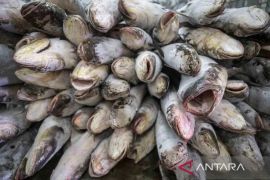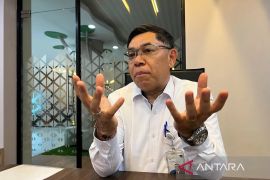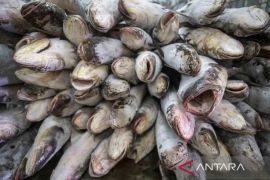Surrounded by beautiful blue seas, and at many places lined by white sandy beaches with many scenic landscapes, Bali is always the foreign or domestic tourist`s preferred destination.
However, not everything in Bali is related to tourism. During my trip to the "Island of Gods" with representatives of the agriculture ministries of 31 countries, including Australia, Italy, Zimbabwe and Nigeria, with Secretary to the Coordinating Ministry for People`s Welfare Indroyono Susilo recently as host, I was introduced to the other face of Bali, namely the location of a center for fisheries research and development in Indonesia.
The research center called the Institute of Research for Mariculture stands tall on a 6.7-hectare plot of land in Gondol, northern Bali. With green hills on one side and Gondol beach on the other, the facility is apparently the only research center for marine life in Indonesia so far.
"This research center has been operating since 1985. Initially it was established to breed milkfish in the area. But after years of research, we also found that the waters here have other potentials. namely shrimp, grouper fish and now we are developing abalone (scallop) as our newest research object," Director of the Marine Research and Development Center for Aquaculture I Nyoman Adiasmara Giri said.
Budi, a researcher working at the facility showed me the way around the facility especially the breeding pool location. He said apart from breeding shrimp, grouper, clownfish, yellow-Fin tuna and milkfish, the facility also done hybridization between tiger grouper and humpback grouper.
He showed me the hybrid fish pool where hundreds of juvenile blue grouper with dots all over their body are being gathered. "We choose to breed grouper because the fish has high economic value in the market. In Indonesia, the fish worth around US$30 each while in Hongkong restaurants the price can hike up to US$30 per plate," he said.
Budi also showed me a big pool with diameter 17 meters and depth six meters where big yellow-fin tuna fish are kept. Budi said the facility now had 130 pools containing milkfish, seven pools for grouper and a net cage in Gondol beach with width 17 kilometres.
He said with the amount of pools and seeds, now 324 people living around the area had used milkfish seeds from the facility while other 40 chose to breed grouper seeds.
"The presence of the facility here has helped creating more job opportunity for the people around as well as increasing their income," Budi said.
After circling around the facility, me and the rest of the participants were brought to another facility called Research Institute for Marine Observation (RIMO) in Perancak, about an hour away from Gondol.
RIMO is a Technical Implementation Unit (UPT) of Marine and Fisheries Research Agency at the Ministry of Maritime Affairs and Fisheries established in 2004. It has a mandate to develop strategic research and application of national marine observations to support the creation of a sustainable marine resource management. In developing its programs of research and observation Brok cooperates with national and international research institutions under the vessel of Southeast Asia Centre for Ocean Research and Monitoring (SEACORM).
Located in Perancak, State, Bali, about 100 km west from Denpasar or 35 km to the east of Gilimanuk, RIMO owns several high technology facilities namely Earth Station Satellite Data Receiver NOAA-AVHRR, Themis Ocean Data, Fiber Optic Internet Connection (256 kbps) and V-Sat (128kbps), Tidal Observer Station, Automatic Weather Station (AWS), Water Quality Laboratory and Mangrove Nature Laboratory.
"RIMO with its satellite facility will broadcast every phenomenon in the ocean and share it with the fishermen. So far we have made products such as map of fishing ground namely in Bali strait, Java, Bali and Nusa Tenggara waters. The map can be directly accessed by the fishermen through internet, radio, fax and even text message. Such information will allow the fishermen to go fishing effectively in the sea," Agus said.
He explained the potential fishing ground map in the facility worked based on the data which was sent from the satellite. He said in order to decide the best place for fishing, the satellite first searched for the presence of chlorophyll in the ocean. According to him, waters with a large amount of chlorophyll was the most probable place of fish since chlorophyll placed first in the food chain in the ocean which will attract plankton and eventually plankton attract fish.
He added the institution had also developed coral monitoring project where they routinely dive underwater to the coral initiative area to analyze and map the distribution of coral reef area.
"Maintaining coral reef is important as a factor that preserve the continuation of fish and eventually human. It must be maintained and protected from the negative impacts of climate change and people?s destructive activity," he said.
Meanwhile, Indroyono Susilo as former Director of National Marine and Fisheries Research and Development Centre as well as the founding father of RIMO expressed appreciation towards the achievement of the institution in helping the fishermen.
"This facility plays an important role in helping the fishermen to effectively find the best location for fishing. Or else they will be circling around the sea, not knowing which place has the most fish and eventually they will lose more time and gas on their search," he said.
Seeing the two facilities in Bali, Kusena Kudzai, a participant from Zimbabwe`s Ministry of Agriculture, expressed his amazement toward Indonesia`s effort in developing its fisheries sector. Meanwhile another participant Yarama Ndirpaya from Nigeria`s Ministry of Agriculture stated his interest to develop Grouper fish breeding with Indonesia. "The grouper fish is seemed to have high economic value, hopefully my country can work together with Indonesia to develop the same project," he said. (*)
Reporter: Amie Fenia Arimbi
Editor: Aditia Maruli Radja
Copyright © ANTARA 2011











